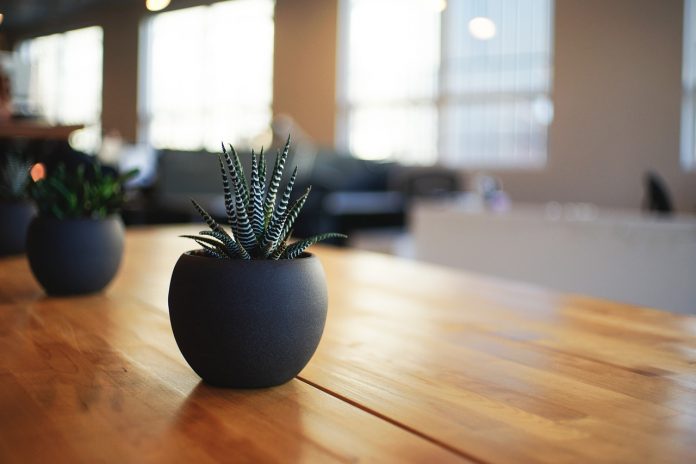Houseplants have been growing in popularity as a way to relieve stress, purify air and bring a bit of nature indoors. They can brighten up an office, living room or kitchen with their vibrant colors or sooth the space with their earthy scents.
Obviously, you want to choose a houseplant that fits your needs, but you want to make a healthy selection to ease long-term maintenance. This is why it’s important to purchase your houseplants at a reputable garden center and fully examine your plant for signs of insects, disease and malnourishment.
It’s also important to consider where you’re planning to put your plant and choose a variety that’s well suited to the location’s light intensity, temperature and humidity level. However, even under similar conditions your new houseplant will take time to adjust after being raised in an ideal greenhouse environment.
More than likely, your new houseplant will become established and bounce back in a couple of weeks. Don’t be too concerned if you notice droopy leaves with brown edges or a slightly different color. Once your plant has adjusted it will start to look healthier.
If it looks like a zombie plant over a longer period of time, you might need to start ruling out common houseplant problems.
Environmental problems
Some of the most common houseplant problems are a result of poor regulation of water, temperature, humidity and light. While it’s easy to give a plant too much or too little of one or more of those factors, it’s also easy to correct them. The tricky part is when one problem is a combination of several factors.
Here is a list of common environmental problems and their causes.
- Spindly plants: Poor lighting conditions.
- Weak growth: Too much or too little light, root system is damaged from poor soil drainage or over-watering.
- Wilting: Over-watering, under-watering, root rot, salt build up, too much fertilizer, needs a larger pot.
- Defoliation: Over-watering, under-watering, needs a larger pot, poor lighting conditions, injured by extreme hot or cold temperatures, low humidity, insects and diseases.
- Yellowing plant: Poor lighting conditions, not enough fertilizer, insects or mites, over-watering.
- Spotty leaves: Watering with cold water or splashing water on leaves can cause white or pale yellow colored spots or patches on the leaves of some plants.
- Yellowing leaves: Over-watering, poor lighting conditions, low humidity, poor soil drainage, injured by low temperatures from a draft.
- Yellowing, browning and death of lower leaves: Nitrogen or iron deficiency.
- Scorched or faded leaves: Too much direct sunlight.
- Reddened leaves: Temperature is too low, phosphorous or potassium deficiency.
- Brown leaf tips: Chemical burn from over applying pesticides or fertilizer, soft water, long stretches of dry soil, temperature is too low, low humidity.
- Small leaves: Soil is either too wet or too dry.
- Small pale leaves: Poor lighting, not enough fertilizer.
- Oedema (rough corky swellings on the undersides of leaves and stems): Over-watering, poor lighting, low temperatures.
- Few flowers: Poor lighting conditions.
- Few flowers and excessive growth: Too much nitrogen fertilizer.
- Bud drop: Not enough fertilizer, too much nitrogen, under-watering, over-watering, spraying with cold water.
- White crust on soil: Salt buildup.
- White or yellow mold like growth: Soil fungus.
Pest Problems
If you’ve ruled out environmental causes as to why your plant isn’t thriving, it may be time to consider some common pests that affect houseplants.
Here is a quick list of the most common insects to watch for:
Aphids: These tiny insects live on the undersides of leaves. They can be green, brown or black in appearance. Look for them if you notice stunted plant growth and curled or distorted foliage.
Mealybugs: They are a scale insect that live on the stems, undersides of leaves and on the nodes of houseplants. They appear white and cottony. Mealybugs cause stunted plant growth.
Mites: Mites are actually tiny, pale spiders. They produce webbing on leaves and stems and can cause distorted yellow leaves.
Scale: These are oval or round, brown insects that live on the leaves and stems of house plants. They suck the plant’s juices and cause stunted plant growth.
Thrips: These very tiny insects are white before maturity and range from tan to dark brown as adults. They feed on flowers and leaves, causing them to become distorted or discolored.
Whitefly: These small, gnat-like insects feed on the leaves of houseplants, which causes them to turn pale shades of yellow or white.
Fungus gnats: As adults they resemble fruit flies and do not cause damage to plants. However, their larvae can sometimes be a problem for plant roots. Certain species of the tiny white and black-headed maggots will feed on the root hairs of plants, causing reduced plant growth.
The best way to get rid of any pest is through non-chemical management, removing insects by hand and wiping off the affected areas.
Diseases
Diseases are probably the least common issue houseplants face as proper environmental conditions promote healthy growth. However, weak plants are more susceptible to infection.
Here are some common diseases and their symptoms:
Anthracnose: Leaf tips turn yellow and then brown with the potential for the entire leaf to die.
Solution: Remove the infected leaves and avoid misting the plant.
Leaf spots: There are two types of leaf spots. Fungal spots appear brown with a yellow halo and will kill either portions or the entire leaf. Bacterial leaf spots appear water soaked and can also have a yellow halo.
Solution: Remove the infected leaves, increase the air circulation around your plant and avoid getting water on the unaffected leaves.
Powdery mildew: A white, powdery fungal growth will start to take over foliage, causing leaf distortion and potentially leaf drop.
Solution: Increase air circulation, ensure the soil is draining properly and remove the severely infected leaves.
Root and stem rots: Rotting will cause stems and roots to appear brown or black and feel very soft. It causes plants to initially wilt and eventually die.
Solution: Rot is primarily caused by over-watering, so you want to avoid this and make sure your soil is draining properly as a preventative measure. In the event of rot where symptoms are affecting some, but not all of the roots you can try to cut out the infected roots and repot the plant.












I’m at a loss over what is wrong with my plant. Can you help ?
Almost all of the leaves, the established ones and the new ones, are brown and crunchy at the tips.
As the leaves grow there is a yellow coloring that begins at the tip of the leaves and continues to the stem. Also, the brown crunchy parts continue to show up through the leaves. I’m not sure what the name of this plant is. The soil drys out frequently so I water with spring or distilled water. One more thing, she is very sensitive to where she is ….. I’ve never put her in direct sun.
Thank you for your website and your knowledge. 😊
I have a Christmas cactus. It was doing really good. Then all the sudden it started to dry out at the leaves and the stem is dry. I put it in a pastice container and still getting worse. So, I went and got a pot and some tropical soil. I finished the plant thinking the plastic container soil was bad. And it looks Like it is dead. It just looks bad. But today I checked plant and the terracotta pot was hot to the touch. And before where it was no problem. What is wrong with it.
Hi!
I have a few questions:
1- I have a money tree that has a squishy trunk. After doing some research, I can guess this is from root rot. How do I save this and prevent this in the future? This is an important plant to me and I need to do everything I can to keep it alive.
2- I have a mini monster, and it suddenly started getting yellow leaves and now only has a few left. I have definitely not been overwatering it but I do not think I have been underwatering it. I live in a VERY dry, arid place and assumed this was a lack of humidity. I put a bag over it to trap humidity and am misting it regularly. It is not getting worse but also not getting better. What should I do?
3- I have this large, healthy, golden pothos that does awesome when I am not watering it, but as soon as I water it gets a few yellow leaves and drains brown/yellow water. Other than that, it looks and feels healthy- any ideas on what caused this?
4- I have been looking for an app where you can take a picture of a sick plant and it will help tell you what is wrong. Any recommendations for one of those that is free?
Thank you!
Addie
Addie, it really seems like whatever potting soil you used for these plants may be trapping moisture around their roots. My recommendation for all of these problems would be to repot these plants with plenty of peat moss and organic matter mixed into the soil to ensure it’s draining well. You can also increase drainage by putting a layer of gravel at the bottom of the pot. Using clay pots instead of plastic will also help keep roots from getting soggy. Plastic pots can trap moisture around plant roots and cause root rot. PictureThis – Plant Identifier has an auto-diagnosis tool, but I’m not sure how many uses you get before it wants you to sign up for a premium account. Flourish – Plant Care Companion is a good free app. It doesn’t have an auto-diagnosis tool for disease, but it has a database of house plants that provides specific care tips and common problems for a wide range of plant species. Best of luck to you and your plants!
The bottom of my spider plant has gone brown and weak and it’s happening to my basil too. Can you help me please?
My quick guess would be root rot, and if it’s made it to the stems of the plants there’s probably no saving them, unfortunately.